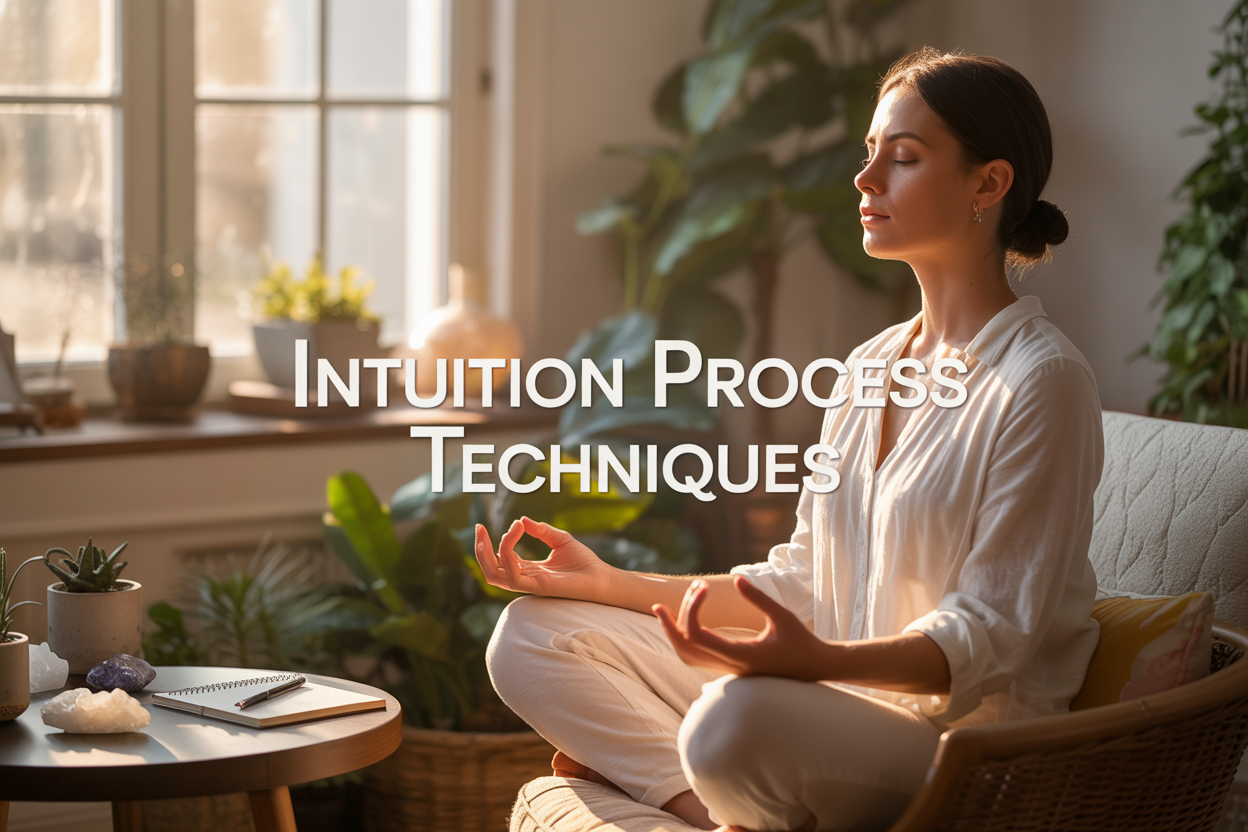Your inner voice has valuable insights waiting to be heard. This comprehensive guide to intuition techniques will help you tap into your natural ability to make better decisions and navigate life with greater clarity.
This step-by-step process is designed for anyone who wants to develop intuition – from complete beginners who’ve never paid attention to their gut feelings to those already practicing who want to strengthen their intuitive abilities. You don’t need special gifts or years of meditation experience to get started.
We’ll explore how to recognize your unique intuitive signals that your body and mind naturally send you every day. You’ll discover practical methods for creating the right conditions where your intuitive guidance can emerge clearly, free from mental chatter and daily distractions.
The guide also covers specific intuition exercises you can practice daily to build your intuitive decision making skills like a muscle. By the end, you’ll have a reliable toolkit for accessing your natural intuition whenever you need clarity in both small choices and major life decisions.
Understanding Your Natural Intuitive Signals

Recognize Physical Sensations That Guide Decision-Making
Your body constantly sends you subtle signals about people, places, and situations. These physical sensations are your natural intuition techniques at work, providing valuable guidance before your mind has time to analyze. Pay attention to that familiar “gut feeling” – the literal sensation in your stomach area that tightens when something feels wrong or expands when an opportunity aligns with your path.
Different people experience intuitive physical signals in various ways. Some feel tingling in their hands when touching objects with positive energy, while others notice tension in their shoulders around certain individuals. Your chest might feel light and open when you’re headed in the right direction, or heavy and constricted when you’re forcing something that isn’t meant to be.
Start tracking these sensations in different environments. Notice how your body responds when you walk into various rooms, meet new people, or consider different options. Your heart rate might quicken with excitement about genuine opportunities, distinct from the rapid pulse of anxiety. Developing intuition requires learning your personal physical vocabulary – the unique way your body communicates with you.
Create a simple body scan practice by checking in with yourself throughout the day. Notice any shifts in energy, breathing patterns, or muscle tension when faced with decisions, big or small.
Identify Emotional Responses to Different Situations
Building intuition skills involves recognizing the emotional undertones that accompany different experiences. Your emotional responses often contain important information about situations before your rational mind catches up. Natural intuition speaks through sudden waves of excitement, unexplained feelings of peace, or immediate emotional reactions that seem to come from nowhere.
Watch for emotional responses that feel disproportionate to the actual situation. That instant dislike of someone you just met might be your intuition picking up on subtle energy cues your conscious mind missed. Similarly, feeling unusually drawn to a particular path or opportunity often signals alignment with your deeper knowing.
Emotions from intuitive guidance tend to feel clean and clear, even when they’re uncomfortable. They arise without a long story attached and often carry a sense of knowing rather than confusion. These feelings might include:
- Sudden clarity about a relationship or situation
- Unexplained excitement about a new direction
- Peaceful certainty even when facing uncertainty
- Instant knowing that something is right or wrong
- Emotional shifts that happen without obvious triggers
Keep an emotion journal for developing intuition more effectively. Note when strong emotional responses arise and track whether following or ignoring these feelings leads to positive or challenging outcomes.
Distinguish Between Fear-Based Thoughts and Genuine Intuitive Insights
The biggest challenge in strengthening intuition lies in separating authentic intuitive guidance from fear-based mental chatter. Fear-based thoughts typically feel frantic, repetitive, and create a sense of urgency or panic. They often contain “what if” scenarios and worst-case thinking patterns that spiral into anxiety.
Genuine intuitive insights feel different. They arrive as quiet knowing, often accompanied by a sense of calm certainty. Intuitive guidance doesn’t usually shout – it whispers with confidence. Where fear creates confusion and endless mental loops, real intuitive decision making brings clarity and peace, even when the guidance challenges your current plans.
Fear-based thoughts often sound like your inner critic or reflect societal conditioning about what you “should” do. They focus on avoiding problems rather than moving toward something positive. Intuitive guidance, however, feels expansive and often encourages growth, even when it involves temporary discomfort.
| Fear-Based Thoughts | Intuitive Insights |
|---|---|
| Create panic and urgency | Feel calm and certain |
| Focus on worst-case scenarios | Provide clear direction |
| Generate endless mental loops | Arrive as simple knowing |
| Feel constrictive and heavy | Feel expansive and light |
| Demand immediate action | Allow natural timing |
Practice intuition exercises by sitting quietly when facing decisions. Let the mental noise settle and notice what remains. True intuitive guidance often becomes clearer in stillness, while fear-based thoughts tend to quiet down when you stop feeding them with attention.
Creating the Optimal Environment for Intuitive Practice

Establish Daily Quiet Time for Inner Listening
Your intuition speaks in whispers, not shouts. Setting aside dedicated quiet time each day creates the space needed for these subtle inner messages to emerge. Even just 10-15 minutes of silence can transform your ability to hear your intuitive guidance.
Pick a consistent time that works with your schedule – early morning before the world wakes up, during lunch breaks, or before bedtime. The key is consistency rather than duration. Your inner wisdom needs to know when you’re available to listen.
During this quiet time, avoid forcing insights to come. Simply sit with yourself and become aware of what’s happening in your body, mind, and heart. Notice any sensations, images, or thoughts that arise without judgment. This practice of inner listening is fundamental to developing intuition and building stronger intuition skills.
Minimize External Distractions and Mental Noise
Modern life bombards us with constant stimulation that drowns out our natural intuition. Creating boundaries around your intuition practice means actively reducing the noise that interferes with your inner awareness.
Start by turning off all electronic devices during your practice time. Put your phone in airplane mode, silence notifications, and create a buffer zone free from digital interruptions. The constant ping of messages and alerts keeps your mind in reactive mode rather than receptive mode.
Mental noise can be just as disruptive as external sounds. Before beginning your intuition exercises, spend a few minutes acknowledging your current worries or to-do list. Write them down if needed, then consciously set them aside for your practice period. This mental clearing helps create space for intuitive insights to surface.
Use Breathing Techniques to Center Your Awareness
Your breath serves as a bridge between your conscious mind and deeper intuitive wisdom. Breathing techniques anchor your awareness in the present moment, which is where intuitive guidance naturally occurs.
Try the 4-7-8 breathing pattern: inhale for 4 counts, hold for 7, exhale for 8. This rhythm naturally shifts your nervous system from stressed alertness to calm receptivity. Your body relaxes, your mind settles, and your intuitive channels open more easily.
Box breathing offers another powerful centering technique. Breathe in for 4 counts, hold for 4, exhale for 4, hold empty for 4, then repeat. This creates a steady rhythm that helps quiet mental chatter and heightens your sensitivity to subtle inner guidance.
Focus on breathing into your belly rather than your chest. This deeper breathing activates your parasympathetic nervous system, creating the optimal state for accessing intuitive information.
Choose Physical Spaces That Support Reflection
Your environment significantly impacts your ability to connect with intuitive guidance. Certain spaces naturally support inner reflection while others create resistance or distraction.
Look for spaces that feel peaceful and contained. This might be a quiet corner of your bedroom, a spot in your garden, or even a parked car if that’s your most private space. The location matters less than how it makes you feel – safe, calm, and undisturbed.
Natural elements enhance intuitive connection. If possible, practice near plants, natural light, or with a view of nature. Even a single houseplant or a small fountain can shift the energy of a space to support your developing intuition.
Keep your chosen space consistent when possible. Your body and mind will begin to associate this location with inner reflection, making it easier to drop into an intuitive state. Some people create a simple altar or dedicated corner with meaningful objects, while others prefer completely unadorned spaces. Trust what feels right for your intuition practice.
Developing Core Intuition-Building Exercises

Practice Body Scanning for Energetic Awareness
Body scanning serves as your gateway to recognizing how your physical self communicates intuitive insights. Start by finding a comfortable position and closing your eyes. Begin at the top of your head and slowly move your attention down through each part of your body. Notice areas that feel tense, warm, light, or heavy. These physical sensations often carry messages about situations, people, or decisions you’re considering.
When practicing this intuition technique, pay special attention to your stomach area – many people receive their strongest intuitive signals through gut feelings. Your heart center might flutter or expand when something aligns with your truth, while your shoulders might tense when encountering resistance. Regular body scanning helps you recognize your personal energetic signature and builds a stronger connection to your natural intuition.
Practice this exercise daily, even if just for five minutes. Over time, you’ll notice patterns in how your body responds to different thoughts, situations, or people in your life.
Use Visualization Techniques to Access Inner Wisdom
Visualization opens direct pathways to your subconscious mind, where much of your intuitive guidance resides. Create a mental sanctuary – perhaps a forest clearing, ocean beach, or cozy library – where you can meet with your inner wisdom. This sacred space becomes your go-to location for accessing deeper insights.
Once you’ve established your visualization space, practice asking questions and allowing images, symbols, or scenarios to emerge naturally. Don’t force or judge what appears. If you’re facing a decision, visualize yourself in each possible scenario and notice how your body responds within the visualization. Does one path feel expansive while another feels constricted?
Another powerful visualization technique involves imagining yourself as an older, wiser version of yourself. What advice would this future self offer about your current situation? These developing intuition exercises work because they bypass your analytical mind and tap directly into your intuitive knowing.
Experiment with Free-Writing for Subconscious Messages
Free-writing unlocks messages from your subconscious that your conscious mind might overlook or dismiss. Set a timer for 10-20 minutes and write continuously without stopping to edit, correct, or even think about what you’re writing. Let your hand move across the page while your mind takes a backseat.
Start with a question or situation you’re curious about, then let your pen do the talking. Don’t worry about grammar, spelling, or whether what you’re writing makes sense. The goal is to bypass your inner critic and allow deeper wisdom to flow through your words.
Many people discover surprising insights buried within their stream-of-consciousness writing. Patterns emerge, solutions appear, and clarity develops around complex situations. This intuition practice becomes more powerful with repetition as you learn to trust the process and recognize when genuine insight is flowing through your writing.
Apply Mindful Walking to Enhance Present-Moment Awareness
Walking meditation sharpens your ability to receive intuitive guidance by anchoring you in the present moment. Choose a familiar route where you won’t need to navigate traffic or obstacles. Begin walking at a slower pace than usual, focusing on the sensation of your feet touching the ground.
As you walk, allow your mind to settle into a receptive state. Notice what draws your attention – a particular tree, building, or sound. Often, these seemingly random observations carry symbolic messages related to questions you’ve been pondering. Your intuitive decision making abilities strengthen when you practice receiving guidance through your environment.
Try walking with a specific question in mind, then notice what thoughts, feelings, or observations arise during your walk. This strengthening intuition technique works because physical movement helps quiet mental chatter while keeping you grounded in your body’s wisdom.
Test Quick Decision-Making Without Overthinking
Rapid decision-making exercises train you to trust your first instinctive response before your analytical mind takes over. Start with low-stakes choices throughout your day – which route to take home, what to eat for lunch, or which book to read next. Notice your immediate gut reaction, then follow it without second-guessing.
Keep a small notebook to track these quick decisions and their outcomes. You’ll likely discover that your initial instincts prove remarkably accurate. This builds confidence in your natural intuition and helps you distinguish between fear-based reactions and genuine intuitive guidance.
Practice the “red light, green light” technique when facing larger decisions. Close your eyes, think about your options, and notice whether your body feels expansive (green light) or constricted (red light) with each choice. Your body’s immediate response often reveals what your mind hasn’t yet processed.
These building intuition skills require consistent practice, but they transform how you navigate daily life and major decisions alike.
Strengthening Your Connection to Intuitive Guidance

Track Intuitive Hits and Misses in a Daily Journal
Your intuitive guidance becomes sharper when you actively track its accuracy over time. Start a dedicated journal specifically for recording your intuitive impressions and their outcomes. Write down your gut feelings about people, situations, or decisions before you have concrete evidence about what will happen.
Create two columns in your journal: “Initial Impression” and “Actual Outcome.” When you meet someone new and get a feeling about their character, jot it down. When you sense a project at work might face delays, make a note. When your intuition tells you to take a different route home, record what prompted that feeling.
After days or weeks pass, return to these entries and mark whether your initial impression aligned with reality. You might discover that your intuition about people’s trustworthiness proves accurate 80% of the time, while your predictions about weather patterns miss the mark completely. This tracking process reveals your natural intuitive strengths and blind spots.
Don’t judge yourself harshly for the misses. Even experienced practitioners of intuition techniques find their accuracy varies across different life areas. The goal isn’t perfection—it’s building awareness of how your inner guidance system operates and where it’s most reliable.
Ask Specific Questions and Wait for Inner Responses
Developing intuition requires moving beyond hoping for random flashes of insight to actively engaging with your inner wisdom. Practice asking your intuitive guidance direct, specific questions rather than vague requests for “a sign.”
Instead of wondering “What should I do about my job?” try asking “Would accepting this promotion serve my long-term goals?” or “Is this the right time to start my own business?” The more precise your question, the clearer your inner response tends to be.
After posing a question, create space for the answer to emerge. This might mean sitting quietly for ten minutes, going for a walk without distractions, or simply carrying the question with you throughout your day while remaining open to responses. Your intuitive guidance rarely operates on your timeline—it responds when you’re receptive, not when you’re demanding.
Pay attention to the first response that comes, even if it seems illogical or unexpected. Your analytical mind often tries to override intuitive messages with “reasonable” alternatives. Write down that first impression before your rational mind can edit or dismiss it.
Some people receive intuitive responses as physical sensations—a tightening in their chest for “no” or a sense of expansion for “yes.” Others experience visual images, hear words, or simply know something without understanding how. Your unique way of receiving intuitive guidance will become clearer through consistent practice.
Notice Recurring Themes and Patterns in Your Insights
Your intuitive guidance often communicates through recurring themes that appear across different situations and time periods. As you build your collection of journal entries, step back periodically to look for patterns in your insights.
You might notice that your intuition consistently warns you about rushing into commitments, even when the logical benefits seem obvious. Or perhaps you repeatedly receive guidance about the importance of creative expression in your life, appearing in various forms across different decisions.
These recurring themes represent your intuitive wisdom trying to guide you toward alignment with your deeper values and life purpose. When the same message shows up repeatedly—whether about relationships, career choices, health decisions, or personal growth—your inner guidance is highlighting something important.
Create a separate section in your journal for tracking these patterns. Monthly reviews work well for most people. Look for:
- Warning signals that appear before challenging situations
- Encouraging nudges that consistently point toward certain directions
- Timing messages about when to act or wait
- Relationship insights about specific people or types of connections
- Health and well-being guidance that appears across different contexts
Pay special attention to themes that initially seem uncomfortable or challenge your existing beliefs. Your rational mind might resist intuitive guidance that suggests major life changes or uncomfortable truths about relationships or career paths. These resistant areas often contain your most valuable insights for personal growth and authentic living.
The patterns you identify become your personal roadmap for strengthening intuition and making decisions that align with your authentic self.
Applying Intuition to Real-Life Decision Making

Use the Pause-and-Feel Method Before Important Choices
The pause-and-feel method transforms how you approach significant decisions by creating space between impulse and action. When facing important choices, take three deep breaths and notice what sensations arise in your body. Your stomach might tighten with one option, while another brings a subtle sense of expansion in your chest. This intuitive decision making technique helps you bypass mental chatter and tap into your body’s wisdom.
Practice this method with decisions like choosing a career move, selecting a home, or evaluating relationship changes. Set a timer for two minutes and sit quietly with each option. Notice physical sensations, emotional shifts, and any spontaneous images or thoughts that emerge. Your intuition often communicates through these subtle bodily responses before your analytical mind kicks in.
Combine Logical Analysis with Intuitive Input
Effective intuitive guidance works best when paired with rational thinking, not as its replacement. Create a decision-making framework that honors both analytical and intuitive insights. Start by gathering facts, researching options, and listing pros and cons. Then engage your intuitive faculties to sense which path feels most aligned with your deeper knowing.
Consider creating a simple two-column comparison:
| Logical Analysis | Intuitive Insights |
|---|---|
| Financial implications | Gut feeling about timing |
| Practical considerations | Energy levels around each option |
| Risk assessment | Dreams or synchronicities |
| Timeline constraints | Body sensations when imagining outcomes |
This building intuition skills approach prevents you from making purely emotional decisions while ensuring you don’t ignore valuable non-rational information. Your logical mind provides the map, while your intuition acts as the compass pointing toward your authentic direction.
Trust Your First Instinct in Low-Stakes Situations
Daily life offers countless opportunities to practice developing intuition through small choices. When deciding what to eat for lunch, which route to take home, or what book to read next, notice your immediate response before overthinking begins. These low-pressure moments become training grounds for recognizing your intuitive voice.
Start paying attention to your first instinct when meeting new people, choosing items at the store, or deciding how to spend free time. Track these quick decisions and their outcomes over several weeks. You’ll likely discover your initial hunches prove accurate more often than random chance would suggest.
Natural intuition strengthens through repeated use in safe environments. The barista you immediately felt drawn to conversation with might share exactly the insight you needed. The unexpected detour that felt right could help you avoid traffic or lead to an interesting discovery.
Validate Intuitive Decisions Through Small Action Steps
Transform intuitive hunches into practical wisdom by testing them through small, reversible actions. Rather than making dramatic life changes based on a single intuitive flash, take modest steps that allow you to gather feedback and build confidence in your inner guidance system.
If your intuition practice suggests a career change, start by informational interviews or volunteer work in that field. Feeling called to relocate? Visit the area multiple times, connect with locals, and imagine daily life there. These incremental steps provide real-world validation for your intuitive insights while minimizing risk.
Create an intuition exercises journal to track these small experiments. Record your initial hunch, the action you took, and the outcome. Over time, you’ll develop a personalized understanding of how your intuition communicates and learn to distinguish between genuine guidance and wishful thinking or fear-based impulses.
This systematic approach to strengthening intuition builds trust between your conscious mind and deeper wisdom. Each validated hunch increases your willingness to listen to and act on future intuitive guidance, creating an upward spiral of improved decision-making capabilities.

Your intuitive abilities are already within you – they just need the right conditions to flourish. By learning to recognize your natural signals, setting up supportive environments, and practicing core exercises regularly, you’re building a reliable inner compass that can guide you through life’s complexities. The key is consistency and trust in the process, even when logic seems to pull you in different directions.
Start small and be patient with yourself as you develop this skill. Apply these techniques to everyday decisions first, then gradually work up to bigger choices as your confidence grows. Your intuition becomes stronger the more you use it, so don’t wait for the perfect moment to begin – start listening to that inner voice today and watch how it transforms your decision-making process.









